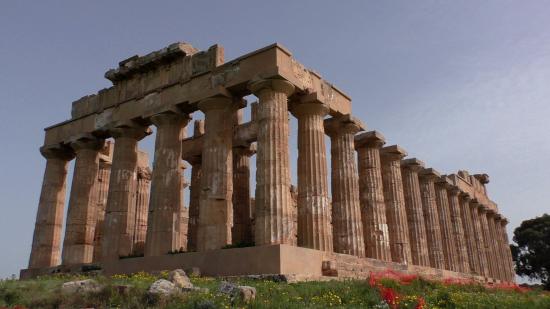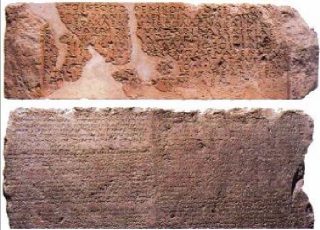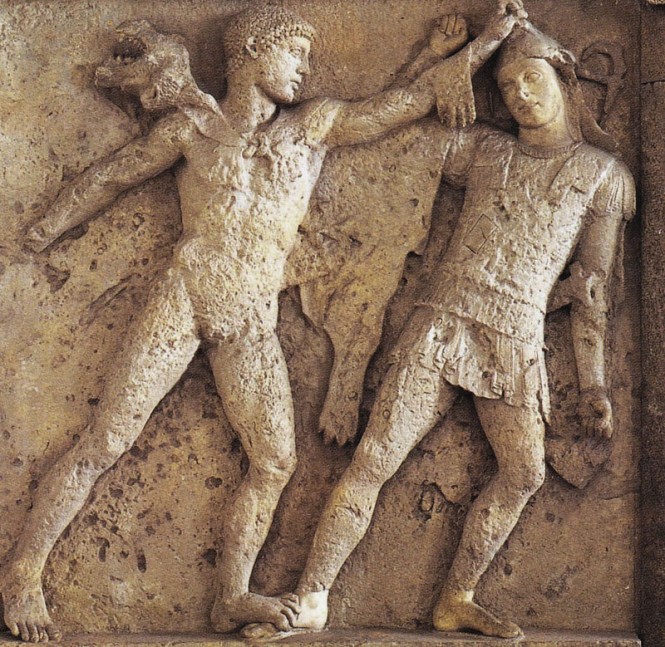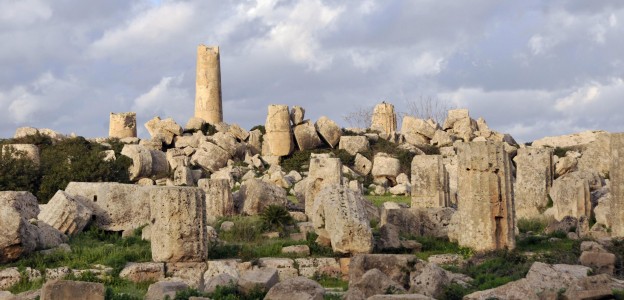The great temples of the east hill
Three great temples lied to the east of the acropolis, on the hill sloping down towards the Cottone valley. Close one to each other, now we can imagine these awesome temples, whose modern names are E, F and G. With their monumentality they dominated the big ancient port of the city and its neighborhoods. The three temples were parallel, along the east-west axis. Scholars hypothesized they were dedicated to Hera, Athena and Zeus.
E Temple, one of the best temples in Sicily
The current temple is the result of a reconstruction that took place in the 50s. For its characters of harmony, proportion and symmetry, the temple E is classified as one of the best examples of Doric architecture in Sicily.
Scholars have also identified a protoarcaic E1 temple, built a few years after the foundation of the colony. This temple collapsed in a fire in 510 BC. Instead, next to it, the E2 temple remained unfinished.
E Temple, a peripteral hexastyle, could be a Heraion, that is in honour of Hera. Inside they found the head of a female statue, now kept at the Regional Archaeological Museum of Palermo.
The sculpture of fine tufa dates back at the beginning of the VI century BC and appears strongly abraded in the face.
Metopes instead are in limestone, but with marble inserts for the nude female parts and in bronze for accessories such as weapons. They seem to confirm the attribution of the temple to Hera, as a deity capable of producing order, or Kòsmos.
The beautiful metopes from temples
The four metopes are among the most beautiful and singular of the Greek age. Kept in the regional archaeological museum of Palermo, they depict :
– Athena fighting with the giant Enceladus;
– Heracles fighting with the queen of the Amazons;
– Atteone attacked by the dogs;
– The hierogamy, or sacred weddings, between Zeus and Hera.
A bright polychromy and a remarkable expressive force characterize these sculptures in which several models of the classical Greek styles but also typical of the place mix together. The compositions have a strong dynamism, an almost violent vivacity and expressions of pain or terror are intense. Each metope has an episodic character, of ended narration.
F Temple
It is a pseudo-peripteral hexastyle temple, archaic doric. Probably it is the most archaic among the temples on the eastern hill because its columns have no entasis. It is in honour of Athena or Dionisio.
The eastern façade of this temple was also adorned with metopes. Only two of the ten metopes that probably constituted the overall decoration remain now.
They show scenes of gigantomachia, the struggle of gods or heroes against monsters or giants who transgressed a divine prohibition. They represent victory of reason and order over bestiality and chaos.
During the excavations in 1823, they found two half metopes in tuff inside the temple. They depicted Dionysius vibrating a blow on a kneeling giant and Athena triumphant on an enemy. These metopes are at the Regional Archaeological Museum of Palermo as well.
G temple
Peripteral octastyle, probably in honour of Zeus Olimpio, it looks such a huge temple, the most awesome of the Selinuntian temples and one of the largest in the Greek world.
The G temple today is a huge mass of ruins among which stands a column called “the spindle of the old woman”. This is only one mighty column, restored by the sculptor Valerio Villareale in 1832.
Because of the long period needed to build it, the original forms underwent a process of adaptation to newer and newer schemes. For this reason the east façade has more archaic characters than the west one.
An inscription was placed inside the G temple. It constitutes the main document listing the gods to whom the inhabitants owed their victories and which the Selinuntians adored.
The great Selinuntina table
 In 1871, among the ruins of the temple, archeologists found the “Great Selinuntina Table”, a very important text on the cults of the city, datable around the middle of the 5th century BC.
In 1871, among the ruins of the temple, archeologists found the “Great Selinuntina Table”, a very important text on the cults of the city, datable around the middle of the 5th century BC.
In the first part we read:
“The Selinuntins win by these gods: we win for Zeus, for Phobos, for Heracles and for Apollon, for Poteidan and for the Tindaids and for Athenaia and for the Malophòros and for Pasikrateia and for the other gods, but above all for Zeus.”
For a long time it was thought the G temple was consecrated to Apollo, also for the analogies with the Apollonion of Miletus. The epigraph also talks of a deposit of sixty gold talents placed inside the temple.
A new interpretation of some scholars attributes this temple to Zeus. He seemed to have the task of preserving the city’s archive. In fact it was a widespread custom in many magnogrecan cities and in the great Syracuse. The Olympieion in Syracuse, also of considerable proportions, was located outside the city walls and used as a city archive.
restoration of G temple
Fifteen million euros would be necessary for the reconstruction of the G temple of Selinunte. The proposal comes from Vittorio Sgarbi, as regional councilor for cultural heritage. According to a first estimate, each of the columns of the temple would cost 180 thousand euros and considering that the building had 50 columns, only the cost of the colonnade would be around 9 million euros.
The discovering of an industrial discrict
The team of the University of Bonn, led by professor Martin Bentz, in collaboration with the German Archaeological Institute of Rome (Deutsches Archäologisches Institut) and the Archaeological Park of Selinunte and Cave di Cusa, recently have conducted excavations inside the archaeological park in the Gorgo Cottone valley, on the eastern side of Selinunte.
Their project investigated a huge industrial district producing Greek earthenware and ceramics. So far, it is the largest industry in the ancient world.
Approximately they have discovered ninety rectangular and circular kilns in the Gorgo Cottone valley, near the river. The circular kilns were very large and used to produce thousands of roof tiles and large ceramic food transport containers. In the large rectangular kilns they produced giant ceramic food storage containers and ceramic coffins.
Other smaller kilns were used to make fine tableware and small statues of gods and goddesses.
It’s now estimated that in the years immediately before the city’s fall in 409 BC, this industrial area would produce about 300,000 ceramic artefacts annually. Less than 20% of that production was for the city’s own use. Almost certainly, many of the larger ceramic products such as amphora, containers for transport, were to export its agricultural production (mainly wheat and olive oil) to foreign markets.
The city before its fall in 409BC
Archaeologists have also found dozens of unfired ceramic products, pots and tiles, workshops complete with pottery-making equipment and even the pigments used to paint the pots. Everything looks like abandoned by terrified local workers before they had had a chance to put them in their kilns.
The harbour
Archaeologists have started investigating Selinunte important ancient harbour. Scientists now are planning to use geophysical survey techniques to find the foundations of the great warehouses which would once have stood around it. Evidence from shops and houses near the city’s market place suggests that the harbour attracted ships and goods from all over the classical world. In some of the city’s temples and richer houses, archaeologists have found imported pottery, glass and bronzes from as far away as Egypt, Turkey, southern France and northern Italy.
Source:
Wikipedia

